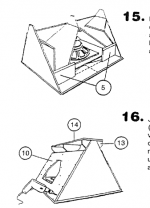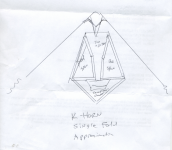why don't you
take a few hours and build a new set of LaScala bins without the top section and fire the mouth of the bin into the corner. Yes you will need a top plate to seal the bin into the corner. This has been done a lot of times with success. Compact and easy set the horn for mid/hi facing forward. Best regards Moray James.
E
Yes these are the issues that I was wondering about. At one time I was postulating a lascala faxing the corner design with one more fold the corner! I thought that that may have merit perhaps get you down to 34 or so. I had thougt it may be as simple as a baffle in the corner and a triangle table top to corner. A two piece extension of lascala.
take a few hours and build a new set of LaScala bins without the top section and fire the mouth of the bin into the corner. Yes you will need a top plate to seal the bin into the corner. This has been done a lot of times with success. Compact and easy set the horn for mid/hi facing forward. Best regards Moray James.
So I have always thought the Khorn had it nailed from as low as I give a damn about up to some minor issues between it and the mid horn. Assuming that I don't give a damn about the length and the only fold I want to keep is the corner it loads to, what would an unfolded Khorn look like? It seems like it might be an easy build? Also I would expect a nicer curve right?
In 1987 R.M. Harris published an analysis [1] of Klipsch’s corner horn beyond that already provided by Klipsch in his various AES papers. Harris’s work includes the "unfolding" you are looking for as well as component dimensions for the enclosure. Less effort will be required to build it as designed, than to execute a simplified redesign that delivers a successful outcome. If you want it bigger, then building E.V. Patrician IV [2][3][4], equipped with a PD 1850 18" driver [5] might be a superior route.
Regards,
WHG
Attachments
Last edited:
It is largely a straight sided exponential, the clever layout allows the exponential expansion in a corner.A straight side exponential would be no issue. Just don't want folds. Seems to me the khorn is largely a straight sided exponential, just folded and bifricated.
If you are going to use the corner, the exponential expansion will still require one fold.
By eliminating the other two folds, you approximately double the cabinet depth and the materials used, and still need almost the same amount of angle cuts to approximate the exponential curve.
This would require designing all those cuts from scratch to approximate the exponential expansion of an existing, well documented design.
Does not seem like any time would be saved in the build, and a day or two would be spent in the layout of a new design that may not work as well as the one being emulated.
I agree completely with whgeiger: "Less effort will be required to build it as designed, than to execute a simplified redesign that delivers a successful outcome."
Art
Attachments
Am I wrong here or could the simplified k horn, less the corner baffle and counting top and bottom be cut from 12 pieces of plywood most of them rectangles?
It is largely a straight sided exponential, the clever layout allows the exponential expansion in a corner.
If you are going to use the corner, the exponential expansion will still require one fold.
By eliminating the other two folds, you approximately double the cabinet depth and the materials used, and still need almost the same amount of angle cuts to approximate the exponential curve.
This would require designing all those cuts from scratch to approximate the exponential expansion of an existing, well documented design.
Does not seem like any time would be saved in the build, and a day or two would be spent in the layout of a new design that may not work as well as the one being emulated.
I agree completely with whgeiger: "Less effort will be required to build it as designed, than to execute a simplified redesign that delivers a successful outcome."
Art
Many years ago, before we had all these free design programs or even computers, I built one horn similar to what weltersys shows but with one extra path for more length. It had two 8" speakers and seemed to work quite well. The speakers were in the corner, behind a baffle sealed to the wall. It used this waste corner space as the rear chamber. It came out a couple of feet and that was tapered as per PWKs rubber throat idea for about 9" then changed to exp. profile. It then returned at a constant height but tapered outwards to the corner baffle then returned back to the room to give the mouth. The sides of the return to the room were built up of layers of plywood strips on the diagonal, as in cold molded boatbuilding practise to give a nice inner curve to the sides of the actual box. From memory it was about two and a half feet tall. Don't know how it would have measured but it sounded real good.
jamikl
jamikl
This got me thinking about that horn again!!! Damn. I think if I did it again, where the plain front of unit, between the two horn mouths, faced the room I would use the boat technique again to make a curved instead of flat front facing the room. This would be a roundover to the inner side of each mouth and done as above with a good veneer which continued into the curved side of each mouth should have a really good decorative factor.
jamikl
jamikl
Yeah let's face it. That kind of horn speaker spoils you forever. Even with its glaring flaws it beats the pants off all other compromises. My much lauded 801s though they are great at the job they do as mastering reference are not fit to kiss PWKs rear end by comparison as listening for pleasure speakers. Sure would like to recreate that sound with my own hands.
You know the more I look into this I'm thinking there will have be a third coming, because the second was just a vacation and he decided to sell speakers in Hope Arkansas for a while. PWK, You just can't beat that guy. There may be a way to improve the drivers perhaps the horn shape, but hell no on the design. The guy was just a genius all the way around.
The speaker baffle would be a single piece, so 11 parts less the corner baffle.Am I wrong here or could the simplified k horn, less the corner baffle and counting top and bottom be cut from 12 pieces of plywood most of them rectangles?
A few less parts than the Khorn.
If you are not opposed to filler material, the original plan is not so difficult to hack out :^).
Last edited:
- Status
- This old topic is closed. If you want to reopen this topic, contact a moderator using the "Report Post" button.
- Home
- Loudspeakers
- Multi-Way
- Unfolding A Khorn.

